Patoleo (also called Patoli) is a dish made in the Indian state Goa and is also popular among natives of Goa settled elsewhere. It is made of grated coconut, rice and jaggery, and cooked by wrapping and steaming in turmeric or banana leaves. Goan Hindus prepare patolyos on the second Sunday of Shravan, on Nag Panchami and on Hartalika, the eve of Ganesh Chaturthi. Salt free patolyos, are offered to Goddess Parvati, who the legends say had a strong craving for these sweets during pregnancy.[1] Among made on the occasion of Our Lady of Assumption feast or on the day of Sao Joao (St. John) feast and Konsachem fest (harvest festival). Patolyos are sent with vojem (trousseau) to the groom’s house, both by the Catholics and Hindus.
Cooking Method
Ingredients
* 1 kg local rice
* 2 coconuts
* 400 gms jaggery
* 1 tsp cardamom powder
* Salt to taste
* Turmeric leaves
Preparation
A thick batter is made by grinding rice that has been soaked overnight with salt. Grated coconut, jaggery and cardamom powder, are heated on slow fire. The batter is applied in a thin layer on the front side of each of the leaves before being stuffed with the coconut mixture. The leaves are then folded and steamed.
Served with leaves on, in a dish. They are mainly eaten after removing the leaf, during afternoon tea time.
-----------------------------------------------------------------------------------------------
| Publication: The Times Of India Goa; | Date: Aug 16, 2008; | Section: Times City; | Page: 4 |  |
A tradition wrapped in leaves Melinda Pereira Kamat expounds the interesting customs associated with the much-loved delicacy, patolyos
Patolyos are steamed rice sweets, a festive food in Goa similar to Orissa’s haldi pitta, but different in taste. Hindus prepare patolyos on the second Sunday of Shravan, on Nagpanchami and on Hartalika, the eve of Ganesh Chaturthi.
Salt free patolyos, are offered to Goddess Parvati, who the legends say had a strong craving for these sweets during pregnancy.
Roman Catholics in Goa prepare patolyos on August 15th –the feast day of Our Lady of Assumption or on the day of Sao Joao feast and Konsachem fest (harvest festival). Patolyos are sent with vojem (trousseau) to the groom’s house, both by the Catholics and Hindus.
Today very few families have retained the tradition of distributing patolyos to neighbours and friends after the arrival of a new born in the family. Patolyos were also distributed to mark the completion of construction of a house.
Catholics send patolyos to a house where people are mourning the death of a family member. Goans prepare three types of patolyos - from rice during monsoon and from jackfruit pulp or cashewnuts mixed with rice during summer. Some families prepare patolyos on Nagpanchami from wheat flour. Generally Catholics prepare patolyos from parboiled rice like korgut, pasni, asgo, whereas Hindus use raw or suroi (polished) rice.
For best patolyos the prerequisite is buying perfect parrot green aromatic haldi-turmeric leaves. My late father would often advise us to replant the turmeric rhizomes. He would say, “When rhizomes remain in the same place year after year the leaves loose their aroma.”
To prepare patolyos, rice is soaked for at least 4 to 5 hours in coconut water and ground to a fine paste with salt. Turmeric leaves have to be cut in rectangular pieces. On either side of the leaf, leave at least half an inch so that the batter does not separate during steaming.
The batter should neither be too thin nor thick, because it comes out while steaming. If by chance the batter becomes watery then add rawa to make it slightly thicker. Batter should be spread thinly and evenly on the dorsal side of the leaf to resemble the thinness of the lamina of the leaf.
For stuffing the batter, Catholics use palm jaggery, whereas Hindus use sugarcane jaggery. Coconut should be double the quantity of jaggery.
For stuffing, relatively dry coconut needs to be grated and cooked for 15 minutes with jaggery and well flavoured cardamom powder called choon, so that it gets caramelized and results in a homogeneous mixture. For added flavour, cashewnuts or raisins could be mixed with the stuffing. The stuffing is to be placed in the middle of the lamina, then folded, sealed and steamed.
In the Konkan region of Maharashtra, grated cucumber or red pumpkin or jackfruit pieces are mixed with the coconut jaggery stuffing. Well prepared patolyos have more stuffing inside and a very thin layer of rice outside.
Well steamed patolyos are judged by the visibility of the stuffing through the rice layer. Steaming of patolyos could be done on a sieve or comfro on high heat for 5 minutes and on slow flame for 15 minutes only. Traditionally bamboo sieves called chalans covered with lid were used for steaming. Patolyos when prepared in a microwave oven do not cook properly.
Some mix rice flour in steaming hot water, cook for sometime then knead and apply paste on leaves. Instant patolyos could be made by soaking rawa or poha (beaten rice) and applying the paste on the leaves after mashing it.
While making jackfruit patolyos no water is used while grinding. Generally rasal (juicy) variety of jackfruit is used for making pansachyo patolyos. Rice has to be ground with equal quantity of jackfruit pulp and the stuffing remains the same. Interesting variants of patolyos are the donnes or puddes, which are cones made from jackfruit leaves. These are prepared with plain rice flour and stuffing.
It was a custom for the neighbours in places like Chorao to invite a girl about to get married and serve her donne for lunch. Catholics still serve donne during an engagement ceremony.
During the jackfruit season, turmeric leaves are unavailable, so patolyos are prepared on banana leaves, leaves of fatarfodiche zaad (Grewelia spp) or cumbyachi panaa (Careya arborea). In the same manner, donnes are also prepared from jackfruit pulp.
When pansachyo patolyos are hot, remove the outer leaves and pour ghee on it. It was a custom amongst rich landlords to prepare cajuchyo patolyos by grinding cashewnuts with rice with the rest of the procedure remaining same.
I loved not only this article but all the articles on this blog, I just wished the writer could keep writing more, posting the article copied from the blog
http://keeptrying.wordpress.com
Patholi is essentially Coconut+Jaggery mixture in rice+coconut paste steamed in turmeric leaves. It is a Konkani specialty and is usually made during Nagpanchami which is when I made these. The magic in this comes from the leaves. It is all about the leaves in fact. They are not just the pot holder here. They impart a very subtle taste to the rice paste during the steaming process that cannot be replicated by any alternative. Well, Banana leaves can be used but it would be a different taste. Good, but not the same. And the aroma, Oh the aroma, to die for. Not before eating a steaming hot patholi, though.
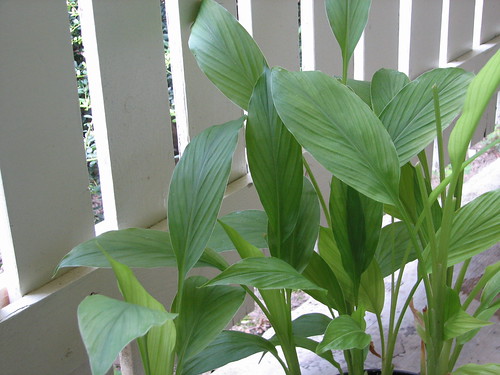

Turmeric Plants in my patio Garden
For the past four years, I made the patholi in parchment papers in the absence of the turmeric leaves. Shilpa has a great post on that.
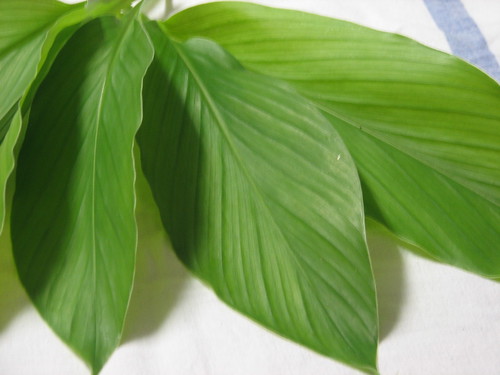
Leaves washed and wiped clean
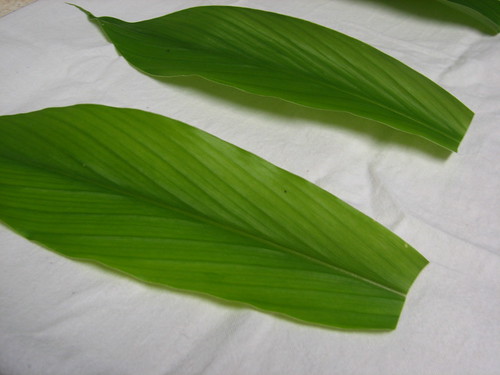
Trimmed and lined for the magic
And the magic happens so.
For the rice paste,
Soak
1 cup raw rice
for 1-2 hours. Grind the rice with
1 cup poha/flattened rice
2-3 tbsp of grated fresh coconut
1/2 tsp of Jaggery, grated
salt, a pinch
with as little water as possible,till it forms a smooth paste. With my blender the way it is, I had to add more water and ended up making it more watery than it is upposed to be. It didn’t hurt the end product, but it was messy applying it to the leaf. This paste needs to be not runny at all. You should be able to scoop it up with your fingers and smear it on the leaf, in the leaf’s shape without the paste running over. Once done, keep aside.
For the stuffing,
Mix, slightly crushing it to release the coconut and jaggery juices,
1 cup Fresh coconut gratings
3/4 cup Jaggery gratings
2-3 Cardamom Pods, crushed and powdered
Let the stuffing begin. Line the leaves on a clean table/counter top. Hold the tip of the leaf with your left hand, scoop some of the paste with your right hand and apply the rice paste, starting at the mid vein of the leaf. Start working outwards to follow the shape of the leaves. The hand instructions reverse if you are left-handed, of course. The paste should be applied in as thin a layer as possible without the green of the leaf coming through.Repeat for all leaves.
Wash hands. Have the steamer ready with the water boiling. Scoop the stuffing and put it on the mid-vein of the leaf in a thin line. This is so that when the leaf is folded over, the stuffing is exactly in the middle and the thin line makes sure that the stuffing does not overflow. When the jaggery melts during the steaming, it will start spreading towards a wider surface area.
Fold one side of the leaf over the other length-wise. Press ever so lightly around the periphery of the leaf, so that paste sticks together. Steam for 10-12 minutes till the kitchen smells of all things wonderful. You will know, you will just know.
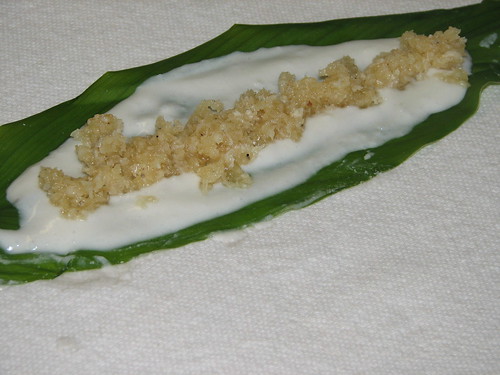
Paste applied and stuffing layered on the leaf.
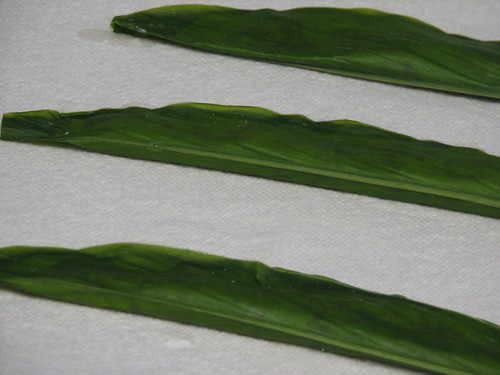
The leaves folded over the stuffing and ready for steaming
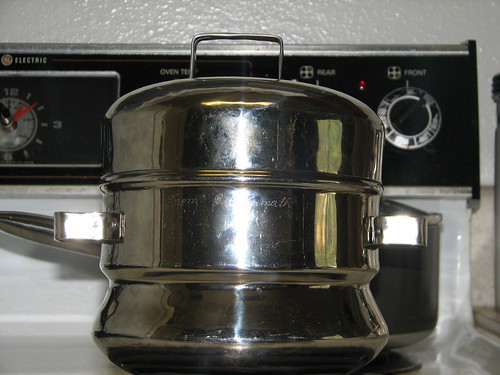
The patholis steaming away to glory in a traditonal steamer. This is called the ‘peDavaNa’ and was a gift from my mother. A more traditional steamer would have been made of ‘pithili’ (brass, I think).

A Patholi uncovered and ready to be devoured.
Believe what I say and don’t believe my camera. The photograph does not do justice to the magic that is patholi.
My entry to JFI-Rice, over at Sharmi’s Neivedyam, and RCI-Karnataka at Asha’a Foodies Hope.
Turns out to be a excellent entry to Green Blog project-Summer 2007 over at Deepz, too.
UPDATE Aug 31 :
Just wanted to clarify that you do not eat the actual leaf. You peel the leaf off a steamed patholi, and just eat whats inside. At this point, the leaf has already given all of its magic to the patholi. The actual dish is the steamed rice + coconut paste with the sweet stuffing inside.
The different names for this sweet in various regional cuisines,
Konkani – Patholi
Kannadiga – Genesale
? – Paangi
View Photos of 3rd Sao Joao Spring Festival

No comments:
Post a Comment